Author: Adam Simmons
Last updated: March 21st 2024
Our key up to date recommendations are given in the table below, grouped by size. Note that some models here are listed as ‘8-bit’ as this reflects the panel capabilities, but can still achieve 10-bit via scaler dithering.
As an Amazon Associate I earn from qualifying purchases made using “Buy” buttons on this page. Where possible, you’ll be redirected to your nearest store. Further information on supporting our work.
Acer XB253Q GP (24.5″ 144Hz IPS, 1920 x 1080)
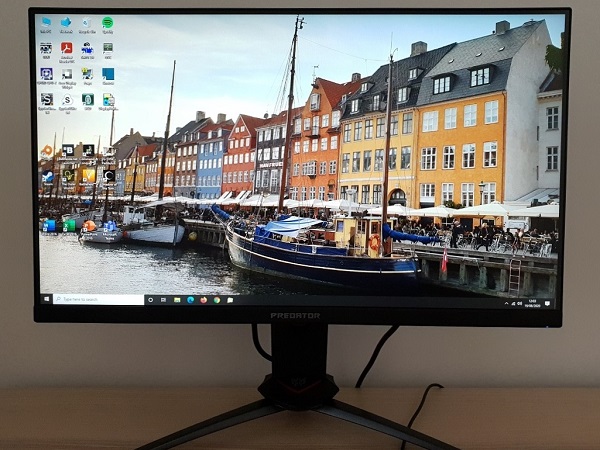
Acer XB253Q GP
- 24.5″ IPS panel (AUO M250HAN01.3 AHVA)
- 1920 x 1080 (Full HD or 1080p)
- True 8-bit
- PWM-free (flicker-free) WLED backlight
- ~sRGB colour gamut and 400 cd/m² peak luminance
- Medium matte anti-glare screen surface
Additional points:
- VESA DisplayHDR 400
- 144Hz (48 – 144Hz VRR, FreeSync via DP + G-SYNC Compatible)
- 2ms grey to grey response time
- 2 HDMI 2.0 ports, DP 1.4, 4 USB 3.0 ports (plus upstream), 3.5mm headphone jack
- 2 x 2W speakers
- Screen is fully adjustable with 100mm VESA support
Why choose this monitor:
The Acer XB253Q GP may be a gaming-focused model, but it’s also well-suited to colour critical work within the sRGB colour space. The monitor offers full sRGB coverage, with just a touch of extension beyond. An effective sRGB emulation setting is also included, cutting down the gamut so it sticks very close to sRGB. Our unit was well-calibrated with respect to gamma, with various gamma settings included. RGB gain and bias controls plus 6-axis hue and saturation adjustment is included to aid fine-tuning. Unlike many competing Full HD models, true 8-bit colour is supported as opposed to the more commonly used 6-bit + FRC dithering.
VESA DisplayHDR 400 support is included, which is only a basic HDR level. The monitor lacks wide gamut support, local dimming or a strong peak luminance by HDR standards. It will still respond to HDR content and supports 10-bit colour processing with the help of GPU dithering, but there’s little ‘HDR’ about this experience. The screen offers solid overall build quality in our view, with a fairly weighty powder-coated metal stand base. Full ergonomic flexibility is also provided and a refresh rate of up to 144Hz is supported with excellent pixel responsiveness for this and lower refresh rates.
Further reading:
BenQ PD2705U (27″ 60Hz IPS, 3840 x 2160)
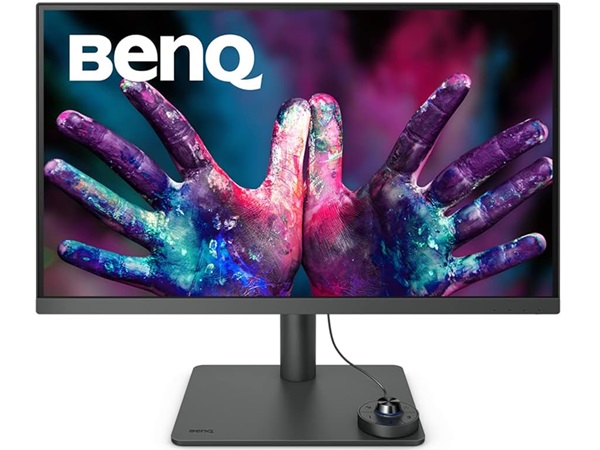
BenQ PD2705U
- 27″ IPS panel
- 3840 x 2160 (‘4K’ UHD)
- 10-bit colour support
- Flicker-free WLED backlight
- ~sRGB colour gamut and 250 cd/m² (SDR) peak luminance
- Light to very light matte anti-glare screen surface
Additional points:
- 60Hz
- 5ms grey to grey response time
- HDMI 2.0, DP 1.4, USB-C (65W PD, DP Alt Mode, upstream data), 3 USB 3.2 Gen 1 ports (plus 2 Type-B upstream), 3.5mm headphone jack
- 2 x 2.5W speakers
- Screen is fully adjustable with 100 x 100mm VESA support
Why choose this monitor:
The BenQ PD2705U provides a 99% sRGB colour gamut with Pantone validated sRGB calibration and specified DeltaE ≤ 3. Uniformity Compensation (UC) is also included to even out brightness and colour temperature at various points of the screen. This monitor doesn’t provide wide gamut support, but is a strong sRGB performer – as with any model accuracy can be further tightened via calibration using your own colorimeter or alternative device. A range of well-tuned Low Blue Light (LBL) settings focusing on viewing comfort are also included, with ‘Hotkey Puck G2’ allowing intuitive OSD navigation.
Basic HDR10 support is included, facilitating work with HDR10 content and allowing 10-bit colour support to be leveraged with a slight brightness boost to ~350 cd/m². The monitor lacks an appropriately wide colour gamut or local dimming to enhance contrast, so it’s very limited in this role. The 3840 x 2160 (‘4K’ UHD) resolution and 27″ screen size provides a tight pixel density for excellent detail and clarity. This is complemented by a light to very light matte anti-glare screen surface, allowing relatively direct emission of light compared to some matte surfaces. The stand includes a solid-feeling coated metal base, with full ergonomic flexibility provided. USB-C connectivity with 65W PD and 2 additional Type-B upstream ports plus KVM integration are also included, for convenience.
Further reading:
Gigabyte M27Q Rev 1.0 (27″ 144Hz IPS, 2560 x 1440)

Gigabyte M27Q
- 27″ IPS panel (Sharp LQ270T1JG08)
- 2560 x 1440 (WQHD or 1440p)
- True 8-bit
- PWM-free (flicker-free) WLED backlight
- ~95% Adobe RGB, 93% DCI-P3 colour gamut and 350 cd/m² (SDR) peak luminance
- Light to very light matte anti-glare screen surface
Additional points:
- VESA DisplayHDR 400
- 170Hz (48 – 170Hz VRR, FreeSync + G-SYNC Compatible)
- 0.5ms MPRT response time
- DP 1.2a+ (HDR feature set), 2 HDMI 2.0 ports, USB-C (10W PD, DP Alt Mode, upstream data), 2 USB 3.0 ports (plus upstream), 3.5mm headphone jack
- Screen includes tilt and height adjustment with 100 x 100mm VESA support
Why choose this monitor:
The Gigabyte M27Q (Rev 1.0) is a surprisingly diverse monitor, but with a colour-critical focus it’s one of the more affordable models on the market offering good Adobe RGB coverage – we measured 95% Adobe RGB in our review. An sRGB emulation setting is included with adjustable brightness, offering tighter tracking of sRGB. This is combined with a 2560 x 1440 (WQHD or 1440p) resolution, delivering a respectable pixel density that works well with a variety of image and video content. The screen also supports true 8-bit colour without dithering, whilst the light to very light matte screen surface with relatively smooth finish aids clarity and vibrancy. It also keeps lighter content free from obvious graininess.
VESA DisplayHDR 400 is supported, which is only a basic HDR level. There’s no local dimming or contrast enhancement, peak luminance is quite limited by HDR standards and DCI-P3 coverage is incomplete. It allows the monitor to put its gamut to good use for HDR10 content whilst allowing 10-bit colour support – with the help of GPU dithering. The monitor supports 170Hz and Adaptive-Sync for VRR, with competent response times. The overall build quality is quite basic, but it ‘does the job’ and fits the monitor which is very affordable given its feature set. The screen also includes tilt and height adjustment.
Further reading:
Some thoughts on this model with respect to its colour gamut and image editing
ASUS PA278QV/CV (27″ 75Hz IPS, 2560 x 1440)
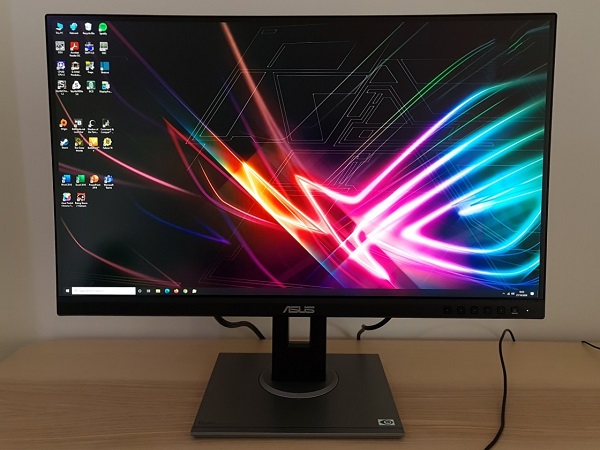
ASUS PA278QV/CV
- 27″ IPS panel (Innolux M270KCJ-L5B AAS IPS-type)
- 2560 x 1440 (QHD or 1440p)
- True 8-bit
- Flicker-free [~20kHz PWM] WLED backlight
- ~sRGB colour gamut and 350 cd/m² (SDR) peak luminance
- Light to very light matte anti-glare screen surface
Additional points:
- 75Hz (48 – 75Hz VRR, FreeSync + G-SYNC Compatible)
- 5ms grey to grey response time
- QV: DP 1.2a, MiniDP 1.2a, HDMI 1.4, Dual-link DVI, 4 USB 3.0 ports (plus upstream), 3.5mm headphone jack, 3.5mm microphone jack
- CV: DP 1.2a, DP out (MST Daisy Chaining), HDMI 1.4, USB-C (65W PD, DP Alt Mode, upstream data), 4 USB 3.0 ports (plus upstream), 3.5mm headphone jack
- 2 x 2W speakers
- QV: Tilt (5° forwards, 35° backwards), height (~150mm or 5.91 inches), swivel (90° left, 90° right) and pivot
- CV: Tilt (5° forwards, 35° backwards), height (~150mm or 5.91 inches), swivel (45° left, 45° right) and pivot
Why choose this monitor:
The ASUS PA278QV and PA278CV offer a colour gamut of 100% sRGB with a bit of extension beyond. We measured 81% DCI-P3 and 76% Adobe RGB coverage, inviting a bit of extra saturation beyond sRGB – but nothing extreme. We deem this acceptable at the hobbyist level, but for maximum sRGB accuracy we’d recommend calibration with a colorimeter or alternative. That’s something we’d ideally recommend with any monitor, though, and in some cases it would be much more vital and impactful than in this case. Our unit was well-calibrated with respect to gamma, whilst the monitor includes a factory calibration complete with printed report. With a claimed DeltaE <2 within the sRGB colour space.
The monitor also features a 2560 x 1440 (QHD or 1440p) resolution with a light to very light matte screen surface and relatively smooth finish. This provides respectable clarity and detail for a variety of content and keeps lighter shades free from obvious graininess. No HDR support is offered, but the monitor has a 75Hz refresh rate for a bit of a boost over 60Hz and that some will welcome even on the desktop. Pixel responses are sufficiently rapid for a good experience at this refresh rate, whilst Adaptive-Sync VRR support is included. The screen offers excellent ergonomics, with the ‘QV’ model feeling particularly solid with a broad stand neck. The ‘CV’ has a more minimalistic stand neck design which doesn’t offer the same level of support to the screen, but includes USB-C which some may find useful.
Further reading:
Our review of the ‘QV’. ‘CV’ is the same aside from ports and stand design
A comparison with the Dell U2719D
A thread focusing on this model for both gaming and photo editing
BenQ PD3205U (31.5″ 60Hz IPS, 3840 x 2160)
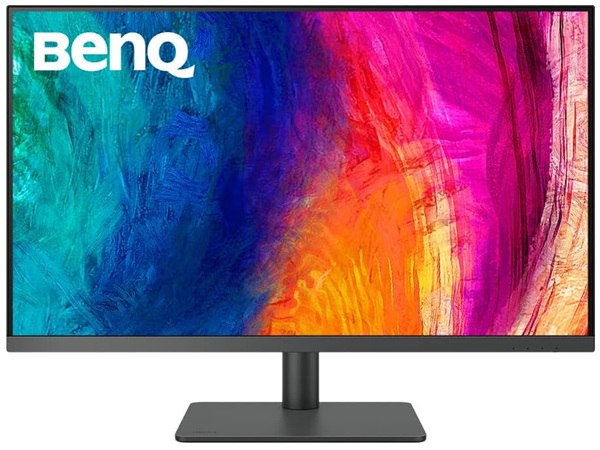
BenQ PD3205U
- 31.5″ IPS panel
- 3840 x 2160 (‘4K’ UHD)
- 10-bit colour support
- Flicker-free WLED backlight
- ~sRGB colour gamut and 250 cd/m² (SDR) peak luminance
- Light to very light matte anti-glare screen surface
Additional points:
- 60Hz
- 5ms grey to grey response time
- HDMI 2.0, DP 1.4, USB-C (90W PD, DP Alt Mode, upstream data), 3 USB 3.2 Gen 1 ports (plus 2 Type-B upstream), 3.5mm headphone jack
- 2 x 2.5W speakers
- Screen is fully adjustable with 100 x 100mm VESA support
Why choose this monitor:
The BenQ PD3205U provides a 99% sRGB colour gamut with Pantone validated sRGB calibration and specified DeltaE ≤ 3. Uniformity Compensation (UC) is also included to even out brightness and colour temperature at various points of the screen. There’s no wide gamut support, but this model performs well within the sRGB colour space. As usual, the accuracy can be further improved by calibrating the monitor using your own colorimeter or alternative device. Various well-tuned Low Blue Light (LBL) settings are included to potentially improve viewing comfort are also included, whilst intuitive control of the OSD is afforded by the ‘Hotkey Puck G2’.
The monitor responds to HDR10 content in a basic way, allowing 10-bit colour support to be leveraged with a slight brightness boost to ~350 cd/m². There’s no local dimming to enhance contrast and the gamut is very limited by HDR standards, though – so its HDR capability is far from strong. The 3840 x 2160 (‘4K’ UHD) resolution and 31.5″ screen size provides an excellent pixel density for pleasing detail and clarity, with a nice amount of ‘desktop real-estate’. It’s a combination many find very practical for work purposes. This is complemented by a light to very light matte anti-glare screen surface, allowing relatively direct emission of light compared to some matte surfaces. The stand includes a solid-feeling coated metal base, with full ergonomic flexibility provided. For added convenience, USB-C connectivity with 90W PD and 2 additional Type-B upstream ports plus KVM integration are also included.
Further reading:
MSI MPG321UR-QD (32″ 144Hz IPS, 3840 x 2160)
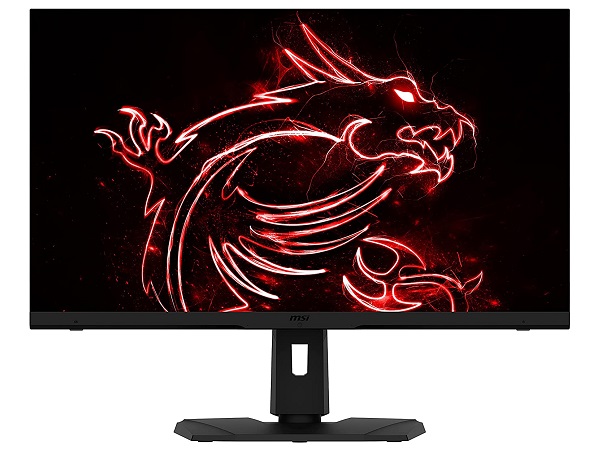
MSI MPG321UR-QD
- 32″ IPS panel (AUO M320QAN02.3 AHVA)
- 3840 x 2160 (‘4K’ UHD)
- 10-bit (8-bit + FRC)
- Flicker-free QD LED backlight
- ~99% Adobe RGB, ~97% DCI-P3 colour gamut and 400 cd/m² (SDR) peak luminance
- Light to very light matte anti-glare screen surface
Additional points:
- VESA DisplayHDR 600
- 60Hz (40 – 60Hz VRR, FreeSync + G-SYNC Compatible)
- 1ms MPRT response time
- 2 HDMI 2.1 ports, DP 1.4, USB-C (15 PD, DP Alt Mode, upstream data), 6 USB 2.0 ports (plus 3 Type-B upstream), a 3.5mm headphone jack, 3.5mm microphone jack and 3.5mm combo jack.
- Screen includes tilt, swivel and height adjustment with 100 x 100mm VESA support
- KVM supported
Why choose this monitor:
The MSI MPG321UR-QD offers ~99% Adobe RGB and ~97% DCI-P3 coverage combined with a 3840 x 2160 (‘4K’ UHD) resolution. This combination makes it particularly attractive for dealing with high resolution content, with strong detail and clarity spread out across a generous screen area. Whilst providing excellent support for extended colour spaces including Adobe RGB and DCI-P3. An sRGB emulation setting is included with adjustable brightness, offering tighter tracking of sRGB. DCI-P3 and Adobe RGB emulation is also provided to help clamp the gamut closer to those colour spaces. The screen also supports 10-bit colour, with a light to very light matte screen surface helping preserve the clarity and vibrancy potential of the screen better than ‘stronger’ matte surfaces.
VESA DisplayHDR 600 support is provided, allowing the screen to put its 10-bit colour processing and generous gamut to good use alongside brightness levels exceeding 600 cd/m². Basic edge-lit local dimming with 16 zones is also included to provide a situational edge in contrast. The monitor includes a generous complement of USB ports plus USB-C with KVM support, for easy USB sharing and display input switching between systems. This is a versatile monitor for both content creation and content consumption.
Further reading:
A comparison with the BenQ EX3210U
ASUS PA32UCG-K (32″ 120Hz IPS, 3840 x 2160)
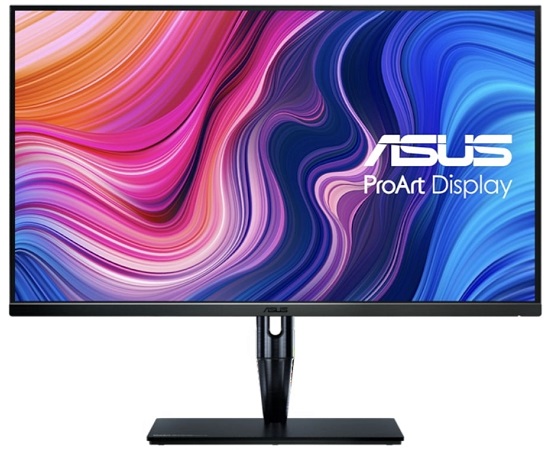
ASUS PA32UCG-K
- 32″ IPS panel (AUO M320QAN02.5 AHVA)
- 3840 x 2160 (‘4K’ UHD)
- True 10-bit
- Flicker-free 1152-zone Mini QD LED backlight
- ~99.5% Adobe RGB, ~98% DCI-P3 colour gamut and 1000 cd/m² (SDR) peak luminance
- Very light matte anti-glare screen surface
Additional points:
- VESA DisplayHDR 1400
- 120Hz (40 – 120Hz VRR, FreeSync + G-SYNC Compatible)
- 5ms grey to grey response time
- 2 Thunderbolt 3 USB Type-C ports (1 in 1 out with 60W PD, DP Alt mode, upstream data), DP 1.4 (with DSC), 1 HDMI 2.1 port, 2 HDMI 2.0 ports, 3 USB 3.0 ports, 3.5mm headphone jack
- 2 x 3W speakers
- Screen is fully adjustable with 100 x 100mm VESA mounting supported
- X-Rite i1Display Pro and detachable shading hood included
Why choose this monitor:
The ASUS PA32UCG-K features a 3840 x 2160 (‘4K’ UHD) resolution spread across a 32″ screen, providing a high pixel density that brings excellent detail to suitably high-resolution content. The Quantum Dot LED backlight solution provides a very generous colour gamut, including; ~99.5% Adobe RGB, 98% DCI-P3, 85% Rec. 2020 and 100% sRGB. This is a Mini LED solution with 1152 dimming zones, which can be used for contrast enhancement under both SDR and HDR. A DeltaE of <1 is specified with factory-calibrated presets including colour space emulation (where applicable). A Uniformity Compensation (UC) feature is also included to help improve brightness and colour temperature uniformity across the screen. Hardware calibration is also supported, with an X-Rite i1Display Pro (Calibrite ColorChecker Display Pro) bundled to facilitate this. Other attractive aspects include; true 10-bit colour, a 1000 cd/m² peak luminance for SDR (1600 cd/m² HDR peak) and a very light matte screen surface to help preserve clarity and vibrancy. A 120Hz refresh rate is also supported, alongside Adaptive-Sync.
The monitor is VESA DisplayHDR 1000 certified, allowing it to put its generous colour gamut and 10-bit colour support to work for HDR10 content. It also allows the 1152-zone local dimming solution to be put to good use, with a peak luminance of 1200 cd/m² provided for very bright light shades. The HLG and Dolby Vision HDR formats are also supported as alternatives. This monitor is more geared towards video editing with relatively strong HDR capability than towards photo editing, as even 1152 dimming zones is a small number compared to the >8 million pixels of the monitor and shade representation can be affected by ‘halos’. Off-Axis Contrast Optimization (OCO) is included to reduce the ‘halo’ effects of local dimming, including when observing the edges of the screen from close up. The manufacturer claims the technology “reduces halo effects by 80% and provides a 7X contrast-ratio enhancement for dark parts of the image when viewing the screen from an angle”. In practice you can still notice some issues of this nature, particularly when observing contrasting content. The monitor has an elegant modern design which combines brushed-effect matte plastics of various tones with internal metal plating, providing a weighty feel to the screen – complemented by full adjustability.
Further reading:
ViewSonic VP3881a (37.5″ 60Hz curved IPS, 3840 x 1600)
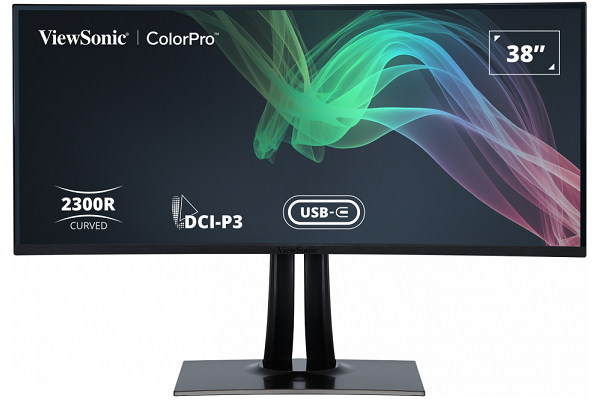
ViewSonic VP3881a
- 37.5″ IPS panel (LG Display LM375QW1-SSB1 IPS)
- 2300R curve
- 3840 x 1600 (UWQHD+ – 21:9 ultrawide)
- 10-bit (8-bit + FRC)
- Flicker-free WLED backlight
- ~95% DCI-P3 colour gamut and 300 cd/m² peak luminance
- Light matte anti-glare screen surface
Additional points:
- Basic HDR10 support
- 60Hz
- 5ms grey to grey response time
- USB-C (90W PD, DP Alt Mode, upstream data) 2 HDMI 2.0 ports, DP 1.4, 3.5mm audio output, 3.5mm audio input, 3 USB 3.2 Gen1 ports (plus upstream)
- 2 x 5W speakers
- Screen includes tilt, swivel and height adjustment with 100 x 100mm VESA support
Why choose this monitor:
The ViewSonic VP3881a combines a 3840 x 1600 (UWQHD+) resolution with strong sRGB colour accuracy and ~95% DCI-P3 coverage for wider colour space work. The pixel density delivered is very good – similar to a 27″ QHD model, with extra horizontal real-estate. The monitor includes a ‘Pantone validated’ factory calibrated with a specified DeltaE <2 and includes a Uniformity Compensation (UC) feature which can be activated to enhance brightness and colour temperature uniformity across the screen. A 2300R (gentle) curve is included to draw you in just a little bit and potentially aid viewing comfort. 10-bit colour is supported via 8-bit + FRC with a 14-bit hardware addressable 3D LUT to enhance precision. Hardware calibration is supported using a compatible calibrator, including a range or X-Rite and Datacolor devices.
The screen surface is light matte anti-glare with a relatively smooth finish, keeping lighter content free from unwanted graininess and helping preserve clarity and vibrancy. Basic HDR10 support is provided, allowing the colour gamut and 10-bit colour capability to be put to use. The colour gamut and backlight capability is not appropriate for actual HDR output, however. USB-C connectivity is included with a generous 90W Power Delivery. Last but not least, the screen is solidly built with good ergonomic flexibility.
Like the sound of this monitor but want something smaller? Consider the VP3481a.
Further reading:
This list is heavily condensed; look out for the recommended or approved badge in our reviews as well. You can sort our reviews by badge status and various other features there.
Accurate colour output is key when it comes to editing photos and videos, certain design work and other content creation. We’ll often refer to this as ‘colour-critical work’. Even for editing at the hobbyist level, we consider accurate colour output the key area to focus on. As such, our recommendations here focus on models with IPS-type panels. These are unmatched by other LCD panel types when it comes to accurate colour output, particularly with respect to colour consistency. You want accurate colour representation throughout the screen, not just in a small central area that may be calibrated to perfection. Non-LCD screens such as OLED are very strong in this area, whilst also offering exceptional contrast. Helping to bring out subtle dark details and distinctions. Penetration of OLED into the monitor market is a slow and ongoing process. For now, such models come at a significant premium and are restricted to a select few models. HDR capability is also increasing, with complex backlighting solutions helping IPS models overcome some of their traditional contrast limitations. There is again a premium attached to such ‘exotic’ technology.
Confused about the terminology? Check out our dedicated guide on the topic.
